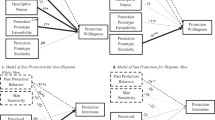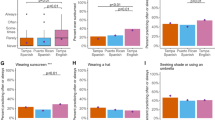Abstract
Background
Showing people a personal ultraviolet (UV) photograph depicting skin damage can be an effective method for changing sun protection cognitions and behaviors.
Purpose
We examined whether people opt not to see their UV photograph if given a choice. We also examined predictors of avoidance of skin damage feedback.
Methods
College students (N = 257) completed questionnaires, viewed example UV photographs, and received the opportunity to see a UV photograph of their face.
Results
Over one-third of participants opted not to see their UV photograph. Greater perceived risk of sun damage and having fewer coping resources corresponded with greater avoidance, particularly among participants who reported infrequent sun protection behavior.
Conclusion
The health benefits of UV photography are realized only if people are willing to view the photograph. Our findings suggest the need for interventions that increase receptivity to viewing one’s UV photograph.


Similar content being viewed by others
References
Centers for Disease Control and Prevention (CDC). Skin cancer. Available at http://www.cdc.gov/cancer/skin/. Accessibility verified August 29, 2014.
Kasparian N, McLoone J, Meiser B. Skin cancer-related prevention and screening behaviors: A review of the literature. J Behav Med. 2009; 32: 406-428.
Fulton JE Jr. Utilizing the ultraviolet (UV detect) camera to enhance the appearance of photodamage and other skin conditions. Dermatol Surg. 1997; 23: 163-169.
Gibbons FX, Gerrard M, Lane DJ, Mahler HI, Kulik JA. Using UV photography to reduce use of tanning booths: A test of cognitive mediation. Health Psychol. 2005; 24: 358-363.
Mahler HI, Kulik JA, Gerrard M, Gibbons FX. Effects of upward and downward social comparison information on the efficacy of an appearance-based sun protection intervention: A randomized, controlled experiment. J Behav Med. 2010; 33: 496-507.
Stock ML, Gerrard M, Gibbons FX, et al. Sun protection intervention for highway workers: Long-term efficacy of UV photography and skin cancer information on men’s protective cognitions and behavior. Ann Behav Med. 2009; 38: 225-236.
Walsh LA, Stock ML. UV photography, masculinity, and college men’s sun protection cognitions. J Behav Med. 2012; 35: 431-442.
Barbour JB, Rintamaki LS, Ramsey JA, Brashers DE. Avoiding health information. J Health Commun. 2012; 17: 212-229.
Sweeny K, Melnyk D, Miller W, Shepperd JA. Information avoidance: Who, what, when, and why. Rev Gen Psychol. 2010; 14: 340-353.
Afifi WA, Weiner JL. Toward a theory of motivated information managaement. Commun Theor. 2004; 14: 167-190.
Brashers DE. A theory of communication and uncertainty management. In: Whaley BB, Samter W, eds. Explaining Communication: Contemporary Theories and Exemplars. Mahwah, NJ: Erlbaum; 2007: 201-218.
Mishel MH. Uncertainty in illness. Image: J Nurs Sch. 1988; 20: 225-232.
Persoskie A, Ferrer RA, Klein WM. Association of cancer worry and perceived risk with doctor avoidance: An analysis of information avoidance in a nationally representative US sample. J Behav Med. 2014; 37: 977-987.
Howell JL, Collisson B, Crysel L, et al. Managing the threat of impending implicit attitude feedback. Soc Psychol Pers Sci. 2013; 4: 714-720.
Melnyk D, Shepperd J. Avoiding risk information about breast cancer. Ann Behav Med. 2012; 44: 216-224.
Howell JL, Crosier BS, Shepperd JA. Does lacking threat-management resources increase information avoidance? A multi-sample, multi-method investigation. J Res Pers. 2014; 50: 102-109.
Howell JL, Shepperd JA. Reducing information avoidance through affirmation. Psychol Sci. 2012; 23: 141-145.
Harris PR, Napper L. Self-affirmation and the biased processing of threatening health-risk information. Pers Soc Psychol B. 2005; 31: 1250-1263.
Liberman A, Chaiken S. Defensive processing of personally relevant health messages. Pers Soc Psychol B. 1992; 18: 669-679.
Sherman DK, Cohen GL. The psychology of self-defense: Self-affirmation theory. In Zanna MP, ed. Advances in Experimental Social Psychology (Vol. 38). San Diego, CA: Academic Press; 2006: 183–242.
Leffingwell TR, Neumann C, Leedy MJ, Babitzke AC. Defensively biased responding to risk information among alcohol-using college students. Addict Behav. 2007; 32: 158-165.
Sherman DAK, Nelson LD, Steele CM. Do messages about health risks threaten the self? Increasing the acceptance of threatening health Messages via self-affirmation. Pers Soc Psychol B. 2000; 26: 1046-1058.
van Koningsbruggen GM, Das E, Roskos-Ewoldsen DR. How self-affirmation reduces defensive processing of threatening health information: Evidence at the implicit level. Health Psychol. 2009; 28: 563-568.
Festinger L. A Theory of Cognitive Dissonance. Stanford, CA: Stanford University Press; 1957.
Cooper J, Worchel S. Role of undesired consequences in arousing cognitive dissonance. J Pers Soc Psychol. 1970; 16: 199-206.
National Cancer Institute (NCI), NIH, DHHS. Cancer trends progress report - 2011/2012 update. Available at http://progressreport.cancer.gov. Accessibility verified August 29, 2014.
Fitzpatrick TB. The validity and practicality of sun-reactive skin types I through VI. Arch Dermatol. 1988; 124: 869-871.
Falk M. Differences in sun exposure habits between self-reported skin type and ultraviolett sensitivity measured by phototest. Photodermatol Photoimmunol Photomed. 2011; 27: 190-195.
Mihalis EL, Wysong A, Boscardin WJ, et al. Factors affecting sunscreen use and sun avoidance in a U.S. national sample of organ transplant recipients. Br J Dermatol. 2013; 168: 346-353.
Shepperd JA, Klein WMP, Waters EA, Weinstein ND. Taking stock of unrealistic optimism. Perspect Psychol Sci. 2013; 8: 395-411.
Howell JL, Shepperd JA. Establishing a scale measure of information avoidance. Unpublished manuscript.
Isaacowitz DM, Choi Y. Looking, feeling, and doing: Are there age differences in attention, mood, and behavioral responses to skin cancer information? Health Psychol. 2012; 31: 650-659.
Walsh LA, Stock ML, Peterson LM, Gerrard M. Women’s sun protection cognitions in response to UV photography: The role of age, cognition, and affect. J Behav Med. 2014; 37: 553-563.
Marquardt DW. You should standardize the predictor variables in your regression models. J Am Stat Assoc. 1980; 75: 87-91.
Hayes AF. An Introduction to Mediation, Moderation, and Conditional Process Analysis: A Regression-Based Approach. New York: Guilford Press; 2013.
Faul F, Erdfelder E, Buchner A, Lang AG. Statistical power analyses using G*Power 3.1: Tests for correlation and regression analyses. Behav Res Methods. 2009; 41: 1149-1160.
Brashers DE. Communication and uncertainaty management. J Commun. 2001; 51: 477-497.
Mahler HI. The role of emotions in UV protection intentions and behaviors. Psychol Health Med. 2014; 19: 344-354.
Howell JL, Shepperd JA. Reducing health-information avoidance through contemplation. Psychol Sci. 2013; 24: 1696-1703.
O’Neill SC, Lipkus IM, Sanderson SC, et al. Motivations for genetic testing for lung cancer risk among young smokers. Tob Control. 2013; 22: 406-411.
Heckman CJ, Wilson DB, Ingersoll KS. The influence of appearance, health, and future orientations on tanning behavior. Am J Health Behav. 2009; 33: 238-243.
Janssen E, van Osch L, de Vries H, Lechner L. The influence of narrative risk communication on feelings of cancer risk. Br J Health Psychol. 2013; 18: 407-419.
Acknowledgements
Laura Dwyer is now at the Behavioral Research Program, Division of Cancer Control and Population Sciences, National Cancer Institute, Rockville, MD.This research was conducted while the first author was a graduate student at George Washington University and was partially funded by an intergovernmental personnel award from the National Cancer Institute to the second author.
Authors’ Statement of Conflict of Interest and Adherence to Ethical Standards
Laura A. Dwyer, James A. Shepperd, and Michelle L. Stock declare that they have no conflict of interest. All procedures, including the informed consent process, were conducted in accordance with the ethical standards of the responsible committee on human experimentation (institutional and national) and with the Helsinki Declaration of 1975, as revised in 2000.
Author information
Authors and Affiliations
Corresponding author
Electronic supplementary material
Below is the link to the electronic supplementary material.
Supplementary Material Table 1
(DOC 38 kb)
About this article
Cite this article
Dwyer, L.A., Shepperd, J.A. & Stock, M.L. Predicting Avoidance of Skin Damage Feedback Among College Students. ann. behav. med. 49, 685–695 (2015). https://doi.org/10.1007/s12160-015-9703-6
Published:
Issue Date:
DOI: https://doi.org/10.1007/s12160-015-9703-6




